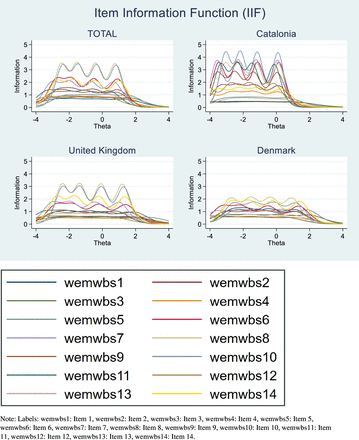Discussion
This study is, as far as we know, the first study to assess over three culturally different populations. The internal structure, reliability and cross-cultural validity of a tool specifically designed for the assessment of mental well-being, the WEMWBS were assessed. Despite the similarities between the populations (all from Europe), and although there were differences in mean well-being scores across the populations assessed, the WEMWBS showed adequate internal consistency, reliability and cross-country comparability. These findings validate the 14-item version of the WEMWBS as a robust unidimensional measure of mental well-being across diverse settings and cultures, reinforcing its suitability for international use, showing measurement invariance at the European level. These results provide valuable support for the measurement of well-being and inform the development of international public policies.
Looking at previous studies focused on the WEMWBS, it should be noted that they have been smaller in scope than the present study. A cross-cultural evaluation of the WEMWBS in Chinese and Pakistani origin populations living in the UK found high levels of consistency and reliability; however, this was only in one country.26 Additionally, in line with the results found, a previous study comparing data from Catalonia and Scotland found significantly different WEMWBS Scores and also demonstrated reliability of the WEMWBS in both countries.14 Besides, to our knowledge, the largest direct cross-country comparison to date of the WEMWBS involved data from Denmark, Iceland, Catalonia and the UK, but it only assessed validity in Denmark.13 Thus, while larger studies involving other populations from different countries worldwide are needed, the results found show the potential of the WEMWBS as a mental well-being measure to be used in multicultural studies and contexts.
The difference in mean WEMWBS Scores between countries is consistent with previous research comparing them.13 On the other hand, these findings are inconsistent with results from international assessments of happiness and well-being. The World Happiness Report (WHR) and the European Social Survey (ESS) both rated Denmark higher for happiness and well-being than the other regions in this study.27 28 This may be due to differences in constructs used for the assessment of well-being. The ESS uses a wide array of questions over many life domains and the WHR used a Cantril Ladder Scale alongside topics as varied as measures of state effectiveness, freedom and social support. A Cantril Ladder involves participants rating these aspects of their life on a scale of 1 to 10. As a result, the ESS and WHR may give a broader view of well-being alongside many other factors (eg, socioeconomic development, political system, environmental factors) and not specifically mental well-being, leading to the difference in results. The WEMWBS provides a more focused measure of mental well-being. To stand out as a tool that can be used both as a population measure and clinical outcome measure needs concise and narrower focus. Furthermore, the conciseness of the WEMWBS lends itself well for use in large-scale population surveys and studies.
The results on the internal structure of the WEMWBS support a strong general well-being factor, consistent with prior studies examining the scale’s dimensionality using bifactor models.8 9 19 The high values obtained for ECV and the ωH coefficient and low ARPB underscore the unidimensional interpretability of the scale for mental well-being. As far as we know, only one other study has calculated some of these indicators, obtaining consistent results.19 The results also show high reliability of the WEMWBS, with minor differences in which items were most discriminatory in each country, which were consistent over different tests. Potential similarities and differences in language, culture and cultural understanding of well-being might lead to differences in items performing between the different countries. This is a well-described phenomenon for self-reported questionnaires using Likert-type items, as the possible differences in response styles over different countries, and the language and translation used, could affect the responses given.29 Factors affecting responses appear to include country-level features such as extraversion, collectivism and uncertainty avoidance influencing response styles.29 However, these factors were not considered in the surveys included in the study and, hence, further research is required to assess the role of these factors in relation to the WEMWBS performance in different cultures.
Several limitations of the study need to be discussed. First, it only assessed data over three populations from Europe, and this could be expanded to include more populations from other regions worldwide in which mental well-being would be considered conceptually different, such as India or African nations. Second, the cross-sectional nature of the data used for this study and the lack of follow-up of participants preclude testing the WEMWBS validity from a longitudinal perspective. Furthermore, the sample from Catalonia is only from one region of a country, while the other two samples are countrywide samples (Denmark and the UK). Differences in mean scores between different regions could be explored further and could be due to a variety of factors in the three regions. Further analysis in future work adopting a longitudinal perspective could be done regarding the validity of WEMWBS and the differences in its scores between demographic groups, for example, gender and age group. Another potential avenue is exploring the reasons for the similarity of discriminatory capacity and reliability across many items in the WEMWBS, which may indicate redundancy. Indeed, the original authors of the WEMWBS developed a Short Warwick Edinburgh Mental Wellbeing Scale (SWEMWBS) including only seven items.30 However, it should be noted that they acknowledge that the SWEMWBS may present a narrower and more restricted view of well-being than the original WEMWBS and the SWEMWBS questions skew more towards eudaimonic and psychological well-being with little coverage of hedonic well-being.30 Additionally, it must be highlighted that the scope of this study is the assessment of the cross-cultural validity of the original and complete WEMWBS, and not the development of a shorter version of the questionnaire. Further research to develop a shorter and cross-culturally valid version of the WEMWBS could be helpful to disentangle these aspects.
To our knowledge, this is the first cross-cultural validation study of the WEMWBS, comparing three different European countries, adding evidence supporting its use and comparability. The results found highlight its potential to be used as a measure of mental well-being in Europe and to make comparisons of mental well-being between countries. Furthermore, it supports the potential of the WEMWBS to be used as an outcome measure in multicultural and multicountry clinical and epidemiological studies in Europe. Despite the fact that further work is needed to assess the cross-cultural validity of the WEMWBS in other European countries and outside of Europe, the results show the validity of using the WEMWBS in surveys and studies across multiple cultures, aiding assessment and potential improvement of population well-being at the population level.


